There are mixed opinions about home methods to increase, improve or protect the Wi-Fi signal, however, researchers from Dartmouth University, in Hanover (USA) confirmed that aluminum foil can contribute to the improvement of the signal and even increase it.
To carry out the experiment, they made rigid plastic support in the shape of an "S" (they used a 3D printer) that they covered with aluminum foil and placed on the router antennas. In this way, it was confirmed that by making an aluminum barrier, the Wi-Fi signal could be better directed, mitigating the impact that insulation and walls produce on the loss of signal in the devices.

Although we do not have a 3D printer to make the support, we can start from the same idea to make our own homemade aluminum screen and improve the Wi-Fi signal, we just have to follow these steps:
-
Cut out card stock about 16" by 12" that is flexible, but strong enough to stand upright.
-
Give it a concave shape to mark the final look it will have.
-
Spread the cardboard again and spread it on both sides with the aluminum foil, exposing the brightest part. Make sure it is very smooth, avoiding wrinkles and thus the signal can bounce well. You can use glue on one side to hold the paper so you can spread it evenly. Start by covering one face first.
-
Do the same to cover the other side and seal both sides while concave to make it look like a satellite dish.
-
To give it stability and stand up, we will make two triangles with equal sides, about 7 cm. We will use them as legs for the aluminum-lined cardboard.
-
We will make a cut of about 3 cm in its upper vertex to fit the aluminum screen in them.
-
Finally, we will place this screen behind the router antennas so that we can direct all the signals to the place we want, thus increasing the signal.
And it is that the aluminum foil has many functionalities beyond wrapping the sandwich. You can also put it to good use to prevent your car from being stolen. To do this, you will only have to wrap the wireless keys with silver foil, thus preventing them from replicating the access code, as the paper forms a kind of barrier that prevents the electromagnetic waves emitted by the wireless key from being captured by a third party.





